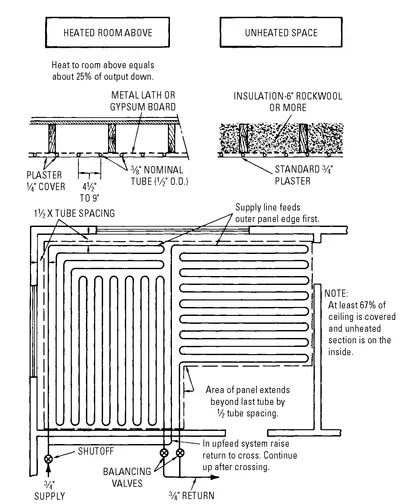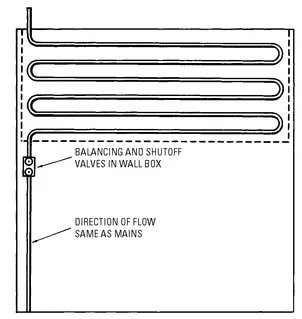![]()
Chapter 1
Radiant Heating
Heat is lost from the human body through radiation, convection, and evaporation. Radiation heat loss represents the transfer of energy by means of electromagnetic waves. The convection loss is the heat carried away by the passage of air over the skin and clothing. The evaporation loss is the heat used up in converting moisture on the surface of the skin into vapor.
Heat transfer, whether by convection or radiation, follows the same physical laws in the radiant heating system as in any other; that is, heat flows from the warmer to the cooler exposure at a rate directly proportional to the existing temperature difference.
The natural tendency of warmed air to rise makes it apparent that this induced air current movement is greater at the cooler floor and exterior walls of the average heated enclosure than at its ceiling. It is through absorption by these air currents that the radiant panel releases the convection component of its heat transfer into the room air.
The average body heat loss is approximately 400 Btu per hour; total radiation and convection account for approximately 300 to 320 Btu of it. Because this is obviously the major portion, the problem of providing comfort is principally concerned with establishing the proper balance between radiation and convection losses.
It is important to understand that bodily comfort is obtained in radiant heating by maintaining a proper balance between radiation and convection. Thus, if the air becomes cooler and accordingly the amount of heat given off from the body by convection increases, then the body can still adjust itself to a sense of comfort if the heat given off from the body by radiation is decreased. The amount given off from the body by radiation can be decreased by raising the temperature of the surrounding surfaces, such as the walls, floor, and ceiling. For comfort, the body demands that if the amount of heat given off by convection increases, the heat given off by radiation must decrease, and vice versa.
The principles involved in radiant heating exist in such commonplace sources of heat as the open fireplace, outdoor campfires, electric spot heaters, and similar devices. In each of these examples, no attempt is made to heat the air or enclosing surfaces surrounding the individual. In fact, the temperature of the air and surrounding surfaces may be very low, but the radiant heat from the fireplace or campfire will still produce a sensation of comfort (or even discomfort from excess heat) to those persons within range. This situation can occur even though a conventional thermometer may indicate a temperature well below freezing. Radiant heat rays do not perceptibly heat the atmosphere through which they pass. They move from warm to colder surfaces where a portion of their heat is absorbed.
This chapter is primarily concerned with a description of radiant panel heating, which can be defined as a form of radiant heating in which large surfaces are used to radiate heat at relatively low temperatures. The principal emphasis will be on hydronic and electric radiant floor heating.
Types of Radiant Panel Heating Systems
Radiant panel heating systems use water-filled tubing or electric heating mats or rolls installed in the floors, walls, and ceilings to distribute the heat. Radiant floor heating is by far the most popular installation method in residential and light-commercial construction.
Note
The word panel is used to indicate a complete system of tubing loops in a single room or space in a structure. It may also be used to indicate a premanufactured radiant floor heating panel.
Floor Panel Systems
Floor panels are usually easier to install than either ceiling or wall panels. Using floor panels is the most effective method of eliminating cold floors in slab construction. Another advantage of heating with floor panels is that much of the radiated heat is delivered to the lower portions of the walls. The principal disadvantage of using floor panels is that furniture and other objects block portions of the heat emission.
Floor panels are recommended for living or working areas constructed directly on the ground, particularly one-story structures. Partial ceiling or wall treatment may be used as a supplement wherever large glass or door exposures are encountered. A typical floor installation is shown in Figure 1-1.
Ceiling Panel Systems
The advantage of a ceiling panel is that its heat emissions are not affected by drapes or furniture. As a result, the entire ceiling area can be used as a heating panel. Ceiling panels are recommended for rooms or space with 7-foot ceilings or higher. A ceiling panel should never be installed in a room with a low ceiling (under 7 feet) because it may produce an undesirable heating effect on the head.
Figure 1-1 Diagram of a typical radiant floor heating installation.
In multiple-story construction, the use of ceiling panels appears to be more desirable from both the standpoint of physical comfort and overall economy. The designed utilization of the upward heat transmission from ceiling panels to the floor of the area immediately above will generally produce moderately tempered floors. Supplementing this with automatically controlled ceiling panels will result in a very efficient radiant heating system. Except directly below roofs or other unheated areas, this design eliminates the need for the intermediate floor insulation sometimes used to restrict the heat transfer from a ceiling panel exclusively to the area immediately below. It must be remembered, however, that when intermediate floor insulations are omitted, the space above a heated ceiling will not be entirely independent with respect to temperature control but will necessarily be influenced by the conditions in the space below. A typical ceiling installation is shown in Figure 1-2.
Figure 1-2 Diagram of a typical radiant ceiling heating panel.
Apartment buildings and many office and commercial structures should find the ceiling panel method of radiant heating most desirable. In offices and stores, the highly variable and changeable furnishings, fixtures, and equipment favor the construction of ceiling panels, to say nothing of the advantage of being able to make as many partition alterations as desired without affecting the efficiency of the heating system.
Wall Panel Systems
Walls are not often used for radiant heating because large sections of the wall area are often interrupted by windows and doors. Furthermore, the heat radiation from heating coils placed in the lower sections of a wall will probably be blocked by furniture. As a result, a radiant wall installation is generally used to supplement ceiling or floor systems, not as a sole source of heat.
Wall heating coils are commonly used as supplementary heating in bathrooms and in rooms in which there are a number of large picture windows. In the latter case, the heating coils are installed in the walls opposite the windows. Wall heating coils will probably not be necessary if the room has good southern exposure. A typical wall installation is shown in Figure 1-3.
Figure 1-3 Typical wall installation. Panel is installed on wall as high as possible.
Hydronic Radiant Floor Heating
Hydronic radiant floor systems heat water in a boiler, heat pump, or water heater and force it through tubing arranged in a pattern of loops located beneath the floor surface. These systems can be classified as being either wet installations or dry installations depending on how the tubing is installed.
In wet installations, the tubing is commonly embedded in a concrete foundation slab or attached to a su...



